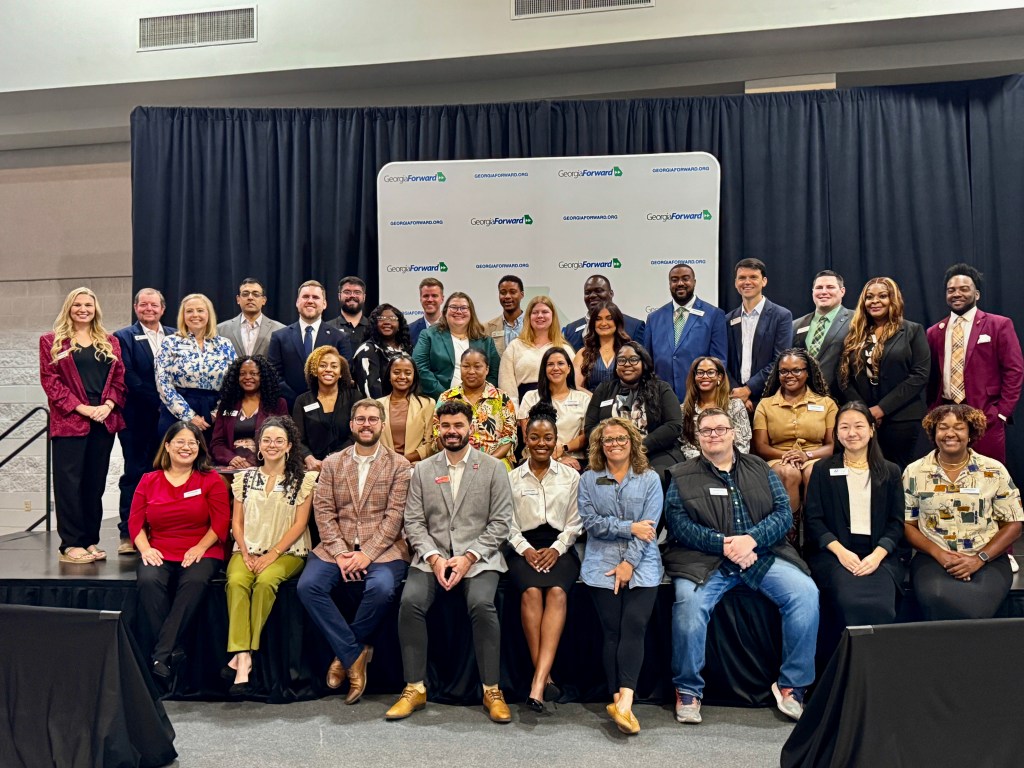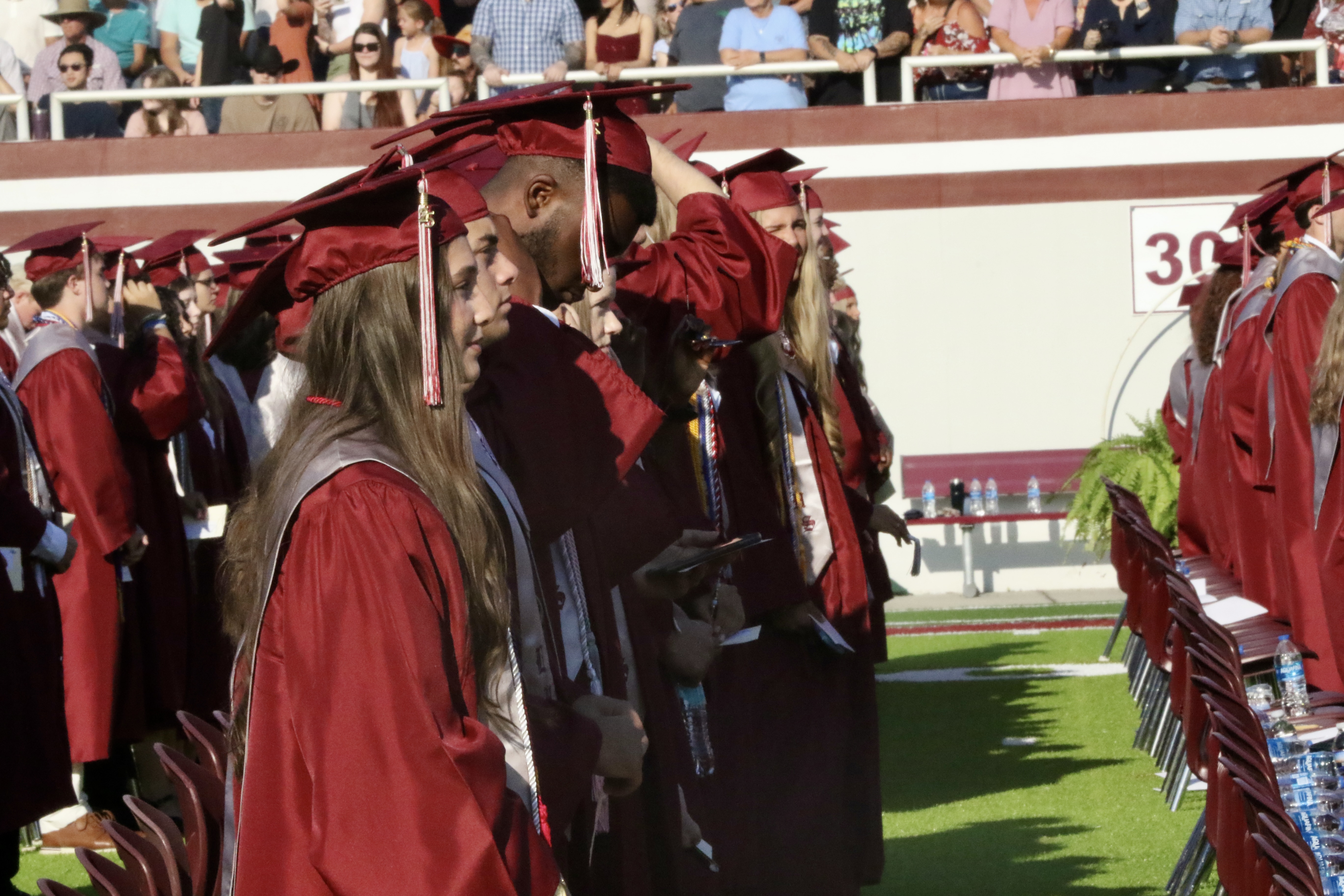Young GameChangers unveil transformative visions for Valdosta’s future
Published 5:22 pm Thursday, November 7, 2024

- Submitted photo: The GeorgiaForward Young GameChangers 2024 class is pictured shortly before presenting their final projects at the Rainwater Conference Center on Wednesday, Nov. 6. Over the past seven months, the Young GameChangers have worked hard to research and compile innovative ideas to help shape Valdosta’s future.
VALDOSTA — On Wednesday, the GeorgiaForward Young GameChangers Program held its final presentations at the Rainwater Conference Center, marking the end of months of dedicated effort by some of Georgia’s brightest young minds.
The event, facilitated by the Georgia Municipal Association in partnership with GeorgiaForward, brought together 45 young professionals who spent months developing innovative solutions tailored to Valdosta’s unique challenges. Known for generating actionable, community-focused proposals, the participants presented plans backed by detailed timelines, potential funding sources, and local partnerships to ensure successful implementation.
The afternoon opened with a warm welcome from Georgia Municipal Association CEO and Executive Director Larry Hanson, followed by remarks from Valdosta Mayor Scott James Matheson and City Manager Richard Hardy. These leaders highlighted the program’s potential to shape Valdosta’s future.
“The Young GameChangers have introduced fresh perspectives and visionary ideas to Valdosta,” Matheson noted. “Their efforts highlight our city’s potential and show the importance of investing in the next generation of leaders.”
As a previous Young GameChangers participant, alumna Kat Cannella introduced the four teams: Team Green, Blended Lines, Team V.I.B.E., and Valdosta Visionaries. Each team delivered a set of “big idea” recommendations designed to address Valdosta’s pressing issues and ensure sustainable development.
Team Green
Team Green presented an ambitious plan to make Valdosta a hub for sustainable parks, trails, and green spaces. Their first initiative, Interconnectivity between Current Ecosystems, seeks to establish a cohesive network of green spaces throughout Valdosta, encouraging outdoor recreation and environmental stewardship. Jacob Bell, a banker and green infrastructure advocate, introduced the idea of connecting “blue ways” along rivers and streams with the broader urban landscape. Team Green proposed securing funding through conservation grants and partnerships with local environmental groups to make this vision a reality.
The second idea of Team Green’s approach, Equity-driven Parks Resource Reallocation Resilience, was introduced by Victoria Ray. She emphasized the need for equity in upgrading Valdosta’s parks, ensuring each community has access to safe, engaging spaces. Their revitalization efforts include sustainable features such as native plant landscaping, solar-powered amenities, and public Wi-Fi, enhancing accessibility and environmental impact. Ray also proposed burying power lines underground to protect against hurricane damage.
The team’s final big idea, Valdosta Eco-Adventure on the Horizon, was presented by Hoa Nguyen and addressed Valdosta and Lowndes County’s limited public access to natural recreational spaces. They proposed that One Valdosta Lowndes (OVL), an organization committed to regional economic growth, lead this initiative due to its partnerships with local government, businesses, and public institutions.
The team’s vision includes developing new parks, trails, and volunteer groups like Keep Valdosta Beautiful to maintain green spaces. They also suggested that a division within Valdosta Parks and Recreation should be dedicated to managing outdoor recreation to ensure sustainable growth and quality maintenance.
Team Blended Lines
Team Blended Lines, introduced by Abigail Carroll from the Valdosta State University Foundation, focused on fostering unity and offering essential support to residents in Valdosta and Lowndes County.
Their first proposal, the TitleTown Leadership Coalition, was presented by Jason Weaver, mayor of Screven, Georgia. This initiative proposes an annual gathering of local leaders, nonprofits, and stakeholders to discuss and fund collaborative community projects. The coalition would rotate leadership among various officials, creating a sense of shared responsibility and reinforcing trust between local government entities.
The second initiative, TitleTown Teammates Mentorship Collective, was led by Madison Beaumarchais. Designed to unify existing mentorship programs, the collective would create an online resource center to link young residents with professional mentors. With partnerships between local schools and businesses, the initiative would pair mentees and mentors for an academic year, promoting continuity and deeper connections. Marché highlighted the collective’s potential to improve academic outcomes, bridge generational divides, and encourage young people to stay invested in Valdosta.
Brandon Moore presented the third initiative, TitleTown Multi-Purpose Center, a facility envisioned as a regional hub for sports, community events, and disaster relief. Celebrating Valdosta’s “TitleTown” legacy, the center would host sporting events, provide scholarships, and support youth athletic programs. With an estimated annual revenue of $25 million, the center promises to be an economic and social asset, fostering resilience and community pride.
Team V.I.B.E.
Team V.I.B.E. (Valdosta’s Innovation Benefits the Economy) presented a forward-thinking economic plan to attract young professionals and foster job growth in Valdosta. Their first initiative, Connecting Valdosta: Virtual Hub and Marketing Blueprint, promotes the city’s unique character through a digital hub and marketing campaign. Erica Grier explained that a dedicated website showcasing Valdosta’s career opportunities and community highlights would enhance Valdosta’s appeal to young talent.
The second initiative, Gateway to Growth: Empowering Talent and Community, introduced by Adam Fulbright, targets vulnerable populations, including homeless parents, at-risk high school seniors, and justice-involved individuals. Programs like “Parent Forward” would provide job training and support for homeless parents, while other initiatives would offer internships for high school seniors and reentry programs for justice-involved residents.
Andrew Moody presented the team’s final significant idea: The YARD Valdosta, A Mixed-Use Facility, a proposed redevelopment project for South Downtown Valdosta. Estimated to cost $18.3 million, this mixed-use space aims to transform underutilized buildings into affordable areas for young entrepreneurs, create an open-air market, and provide multi-family housing. The Yard would become a cultural hub that attracts visitors, supports local artisans, and stimulates economic revitalization, blending history with a vision for modern, inclusive community space.
Team Valdosta Visionaries
Team Valdosta Visionaries presented a revitalization strategy for the historic South Side, focusing on cultural preservation, economic growth, and community support. Their first proposal, Network of Community Resource Hubs, introduced by Jamie Hill, envisions a series of centers offering education, career support, and technology access. These hubs would coordinate efforts with organizations like the Valdosta Commission for Children and Youth, creating an interconnected support network that fosters community engagement.
The second initiative, Soulful Southside Revitalization Plan, presented by Samantha Trust, seeks to repurpose vacant properties, turning them into community spaces that connect downtown with the South Side.
The final initiative, Neighborhood Connectivity, Placemaking & Beautification, introduced by Claire Chan, envisions a heritage trail highlighting significant South Side landmarks and connecting neighborhoods with parks and community resources. The “Spirit Trail” would feature historical markers, tree-lined paths, and scenic routes, drawing visitors and instilling pride among residents. The trail is designed to celebrate Valdosta’s heritage and promote community engagement and tourism.
With the Young Gamechangers’ ideas finalized, it is now up to city and county officials to consider their ideas.





